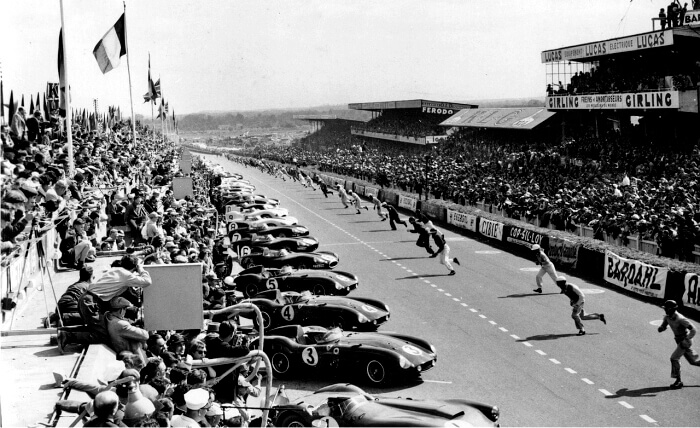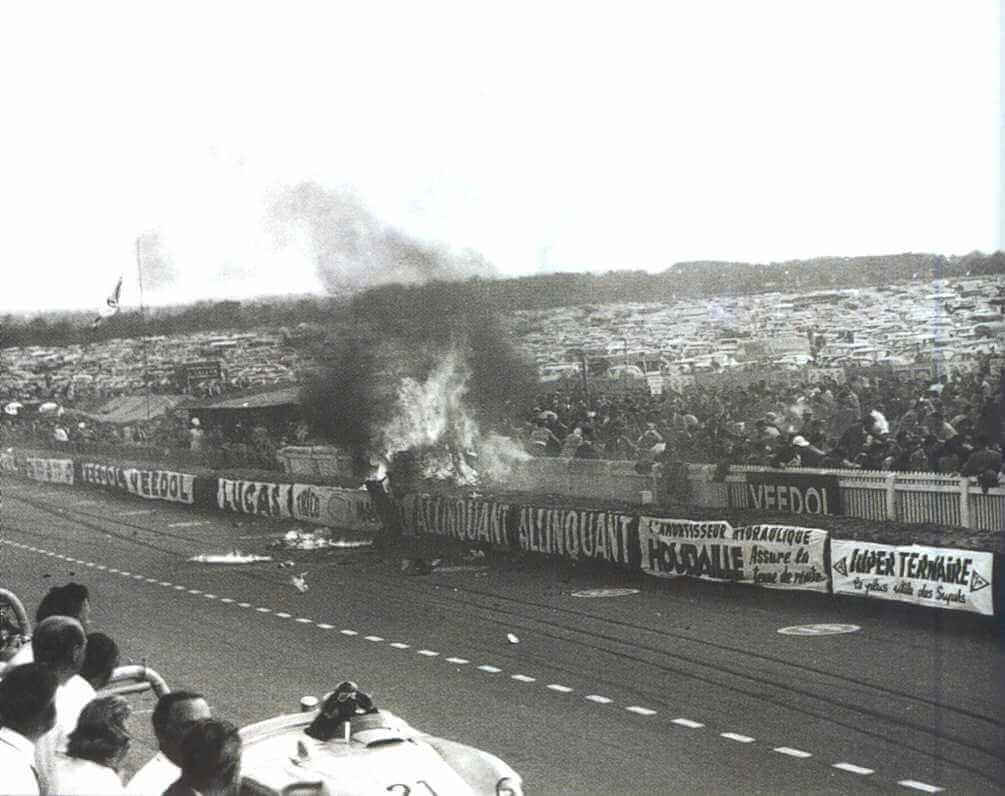The Le Mans Disaster of 1955

The Le Mans disaster of 1955 is the most tragic accident in motor racing history. The accident took the lives of 82 spectators and racing driver; Pierre Levegh. Read along to find out about that fatal day in the French city of Le Mans.
As we previously stated, the accident marked a sad day in motor racing history. Afterward, important changes were made in order to implement safety measures for both the drivers and spectators.
The 1955 Le Mans accident
The accident occurred on June 11th, 1955. Three hours into the race, Juan Manuel Fangio and Stirling Moss led the race, they were followed closely by Mike Hawthorne and Ivor Bueb. Both race leaders already had a lap advantage over the rest of the drivers.
Hawthorne, looking for victory tried to overtake Lance Macklin. However, when performing the maneuver, Hawthorne braked hard, forcing Lance Macklin into the pit.
Behind Macklin however, Pierre Levegh and Manuel Fangio were coming at full speed.
Levegh, who was ahead, realized what was happening and raised his hand in order to warn his partner Fangio of the danger ahead. His Mercedes then ran into Macklin causing his car to become airborne. It flew into the main crowd, where it exploded and caught fire. His car was torn apart by the accident and only the metal structure remained after the fire.
Surprisingly, the race wasn’t even canceled. The victims and injured were treated and the track was cleared while the other drivers tried to complete the race.

The organizers justified that decision by saying that the evacuation of the injured would have been more complicated if at the same time, spectators tried to exit the gallery. In this video, you can see the moment the accident occurred; the images are truly shocking.
Fatal consequences of the Le Mans disaster
As a result of the accident, 82 spectators and racing driver Pierre Levegh lost their lives. In addition, there were more than 70 non-fatal injuries.
The moments after the accident were chilling. Most of the spectators who died were impacted by the front of Levegh’s vehicle. The engine and chassis acted as missiles along with the remainder of the vehicle, causing it to burst into flames.
After hearing the news of the fatal accident, Mercedes decided to leave the race that they were leading at the time. Mercedes decided not to compete again until 1989.
Whose fault was it?
At first, the media blamed Mike Hawthorn since he was the one who started the chain accident by abruptly braking.
Subsequently, his team reported that he’d been warned to urgently refuel and therefore, Hawthorne was simply following his team’s orders.

In the end, Hawthorne wasn’t found to be in the wrong. An investigation carried out concluded that the fatal accident wasn’t the fault of any particular driver. The conclusion was backed up by the opinion of a number of experts and photographic evidence.
Changes in safety measures
After the accident, numerous safety measures were implemented. Until that moment, racing cars weren’t required to have seat belts. It was thought that seat belts would slow down the driver’s exit from the vehicle in case of a fire.
Drivers weren’t required to wear fire-retardant clothing and the helmets didn’t cover their entire head. After the accident, safety measures were implemented to address those issues.
Safety measures were also provided to protect the crowd. They were placed further from the track. So, although the accident allowed for the implementation of various safety measures, it’s sad to think that such a massive tragedy could have been prevented.
The Le Mans disaster of 1955 is the most tragic accident in motor racing history. The accident took the lives of 82 spectators and racing driver; Pierre Levegh. Read along to find out about that fatal day in the French city of Le Mans.
As we previously stated, the accident marked a sad day in motor racing history. Afterward, important changes were made in order to implement safety measures for both the drivers and spectators.
The 1955 Le Mans accident
The accident occurred on June 11th, 1955. Three hours into the race, Juan Manuel Fangio and Stirling Moss led the race, they were followed closely by Mike Hawthorne and Ivor Bueb. Both race leaders already had a lap advantage over the rest of the drivers.
Hawthorne, looking for victory tried to overtake Lance Macklin. However, when performing the maneuver, Hawthorne braked hard, forcing Lance Macklin into the pit.
Behind Macklin however, Pierre Levegh and Manuel Fangio were coming at full speed.
Levegh, who was ahead, realized what was happening and raised his hand in order to warn his partner Fangio of the danger ahead. His Mercedes then ran into Macklin causing his car to become airborne. It flew into the main crowd, where it exploded and caught fire. His car was torn apart by the accident and only the metal structure remained after the fire.
Surprisingly, the race wasn’t even canceled. The victims and injured were treated and the track was cleared while the other drivers tried to complete the race.

The organizers justified that decision by saying that the evacuation of the injured would have been more complicated if at the same time, spectators tried to exit the gallery. In this video, you can see the moment the accident occurred; the images are truly shocking.
Fatal consequences of the Le Mans disaster
As a result of the accident, 82 spectators and racing driver Pierre Levegh lost their lives. In addition, there were more than 70 non-fatal injuries.
The moments after the accident were chilling. Most of the spectators who died were impacted by the front of Levegh’s vehicle. The engine and chassis acted as missiles along with the remainder of the vehicle, causing it to burst into flames.
After hearing the news of the fatal accident, Mercedes decided to leave the race that they were leading at the time. Mercedes decided not to compete again until 1989.
Whose fault was it?
At first, the media blamed Mike Hawthorn since he was the one who started the chain accident by abruptly braking.
Subsequently, his team reported that he’d been warned to urgently refuel and therefore, Hawthorne was simply following his team’s orders.

In the end, Hawthorne wasn’t found to be in the wrong. An investigation carried out concluded that the fatal accident wasn’t the fault of any particular driver. The conclusion was backed up by the opinion of a number of experts and photographic evidence.
Changes in safety measures
After the accident, numerous safety measures were implemented. Until that moment, racing cars weren’t required to have seat belts. It was thought that seat belts would slow down the driver’s exit from the vehicle in case of a fire.
Drivers weren’t required to wear fire-retardant clothing and the helmets didn’t cover their entire head. After the accident, safety measures were implemented to address those issues.
Safety measures were also provided to protect the crowd. They were placed further from the track. So, although the accident allowed for the implementation of various safety measures, it’s sad to think that such a massive tragedy could have been prevented.
All cited sources were thoroughly reviewed by our team to ensure their quality, reliability, currency, and validity. The bibliography of this article was considered reliable and of academic or scientific accuracy.
- Le Mans 1955, el peor accidente en la historia del automovilismo deportivo. 2011. Motor Pasión. https://www.motorpasion.com/otras-competiciones/le-mans-1955-el-peor-accidente-en-la-historia-del-automovilismo-deportivo-parte-2
- Desastre de Le Mans en 1955. Wikipedia. https://es.wikipedia.org/wiki/Desastre_de_Le_Mans_en_1955
This text is provided for informational purposes only and does not replace consultation with a professional. If in doubt, consult your specialist.








